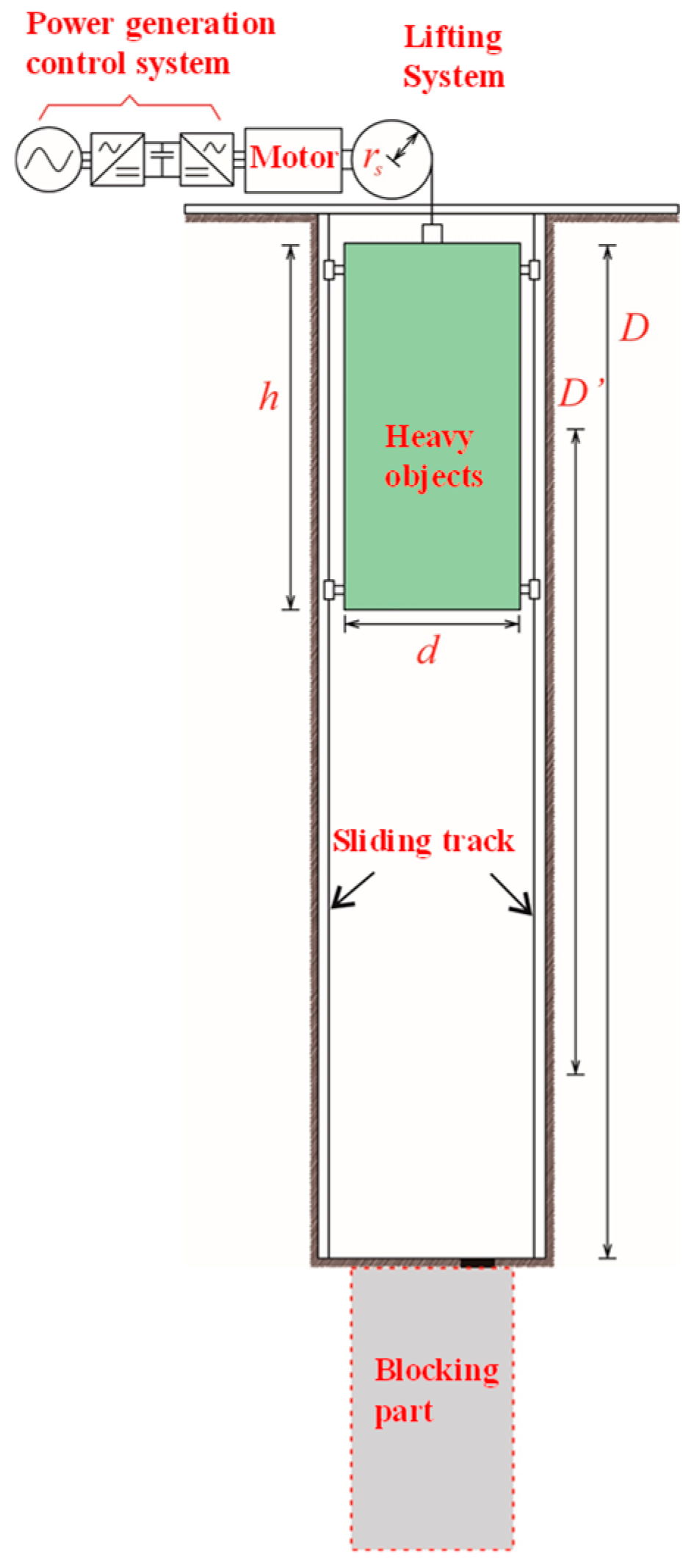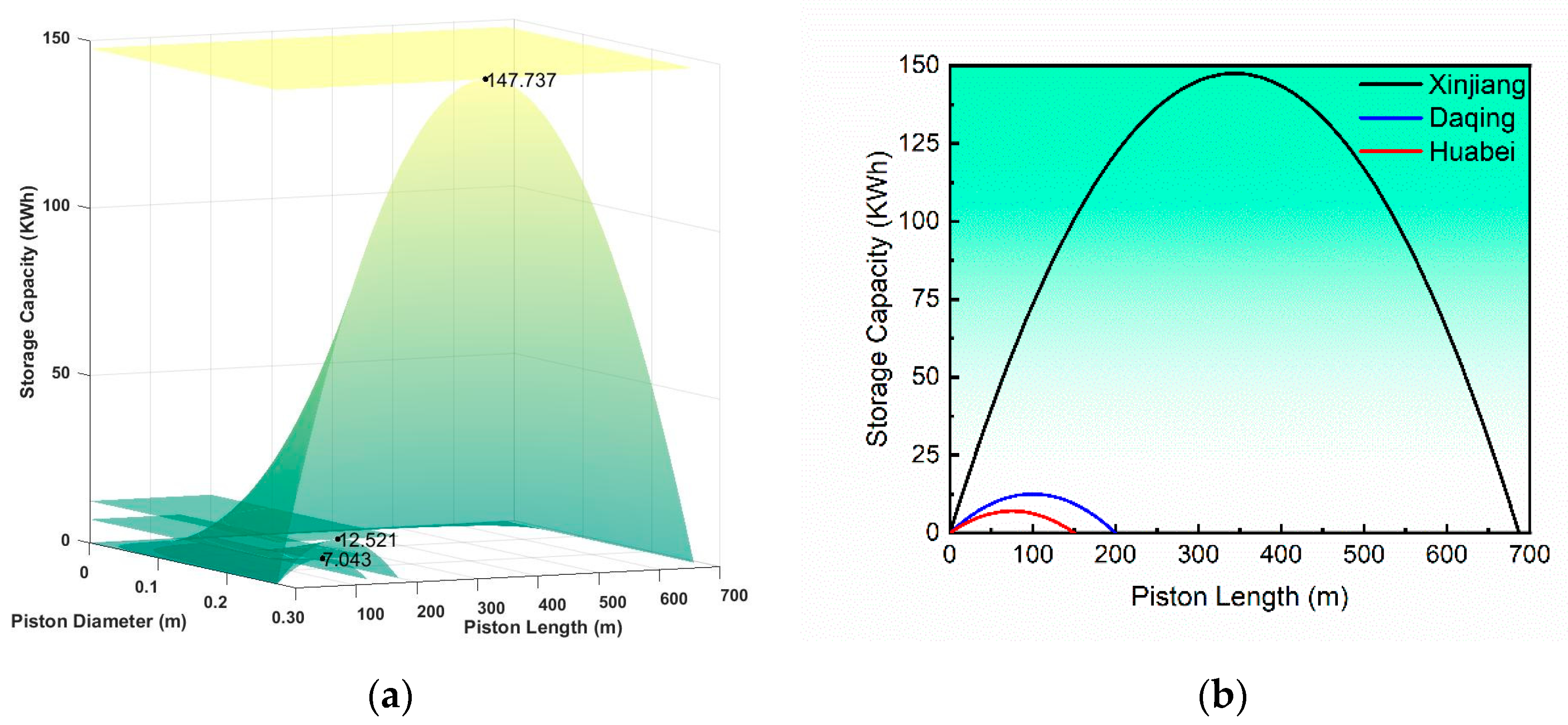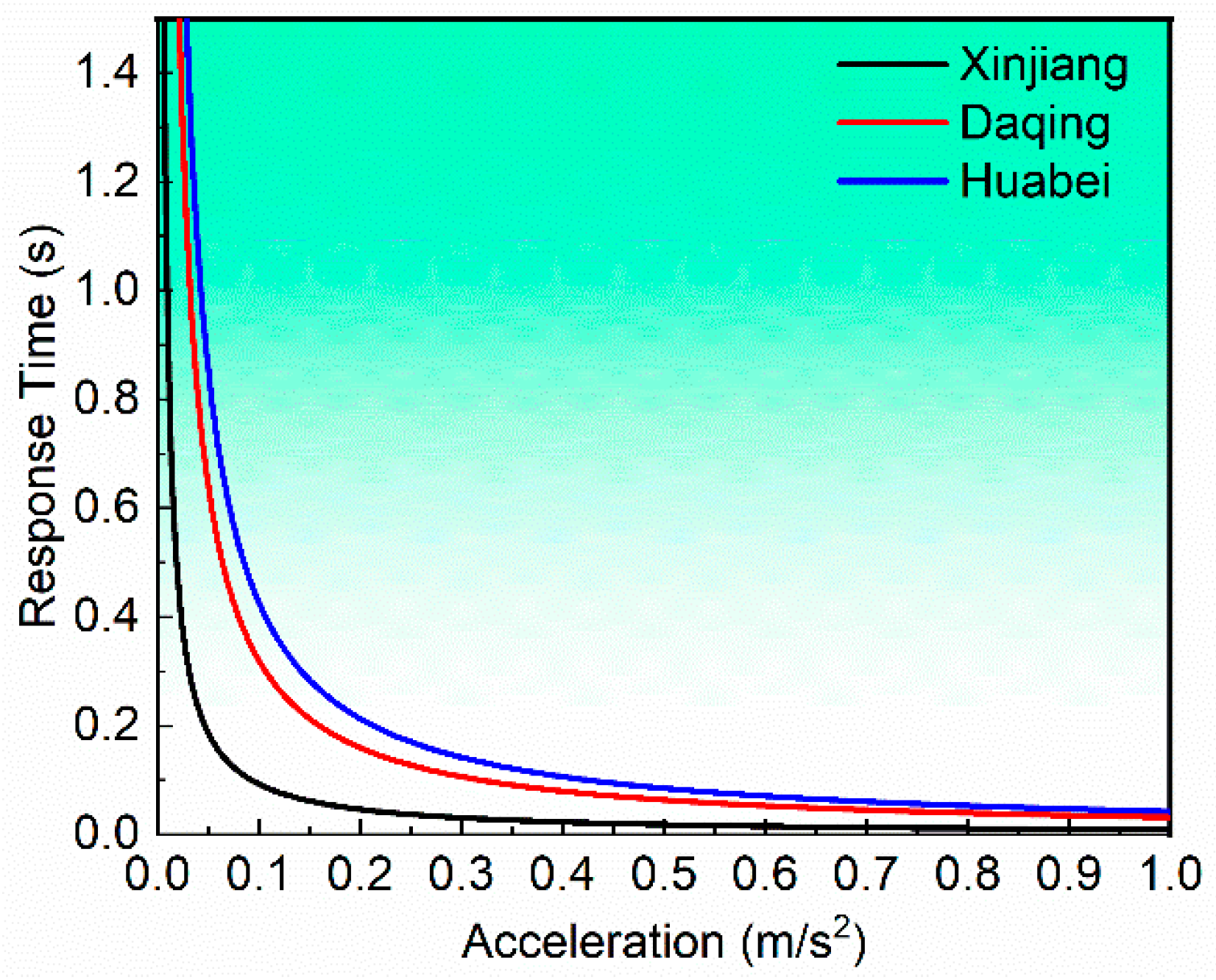A Feasibility Study on Gravity Power Generation Technology by Virtue of Abandoned Oil-Gas Wells in China
Abstract
:1. Introduction
2. Overview of Gravity Energy Storage Methods and Selection of Energy Storage Shafts
2.1. Basic Concepts of Gravity Energy Storage Technology
2.2. Underground Shaft Gravity Energy Storage
2.3. Considerations for Choosing Abandoned Oil-Gas Wells as Gravity Energy Storage Shafts
- (1)
- Abandoned oil wells due to geological reasons, engineering accidents, various damages, etc.
- (2)
- Exploratory wells where there is no oil or gas after drilling.
- (3)
- Old oil wells that have reached the end of their useful lives after years of oil and gas extraction, as well as oil wells with long-term shutdown or low production.
2.3.1. Significance of Establishing the Utilization Mechanism of Abandoned Oil-Gas Wells
2.3.2. Status of the Development and Utilization Technologies for Abandoned Oil-Gas Wells
- (1)
- The existing wellbore can be used for geothermal reconstruction, which greatly reduces well drilling and well capping costs.
- (2)
- The existing production data can be used for setting up scientific and reasonable development schemes.
- (3)
- Geothermal reconstruction using abandoned wells contributes to the promotion and utilization of geothermal energy.
2.3.3. Challenges of Constructing Gravity Energy Storage Systems for Abandoned Oil and Gas Wells
- (1)
- There is little space in abandoned oil and gas wells, so designing and making full use of the weight of the heavy objects will be very important.
- (2)
- Unlike the energy storage tower structure, the integrity of heavy objects in the gravity storage system of abandoned oil and gas wells affects the shape control of heavy objects and makes it difficult to automate intelligently.
- (3)
- Although abandoned oil wells have the possibility of reuse, reutilizing them successfully is one of the key problems to be overcome.
3. Gravity Power Generation Model by Virtue of Abandoned Oil-Gas Wells
- (1)
- Abandoned-well evaluation and optimization technology: There is a need for a wellbore adaptability evaluation of abandoned wells and technical research on wellbore cement plugging, wellbore wall support, and wellbore lining to solve the problems of selection, plugging, and supporting abandoned wells.
- (2)
- Energy conversion technology of underground gravity energy storage systems: There is a need to develop traction and control tools for underground gravity energy storage in addition to underground tracklaying and sliding control systems to solve the problems of the underground movement and control of heavy objects.
- (3)
- Ground control technology for gravity energy storage: There is a need to carry out digital factory simulations to simulate the operation effects of real numerical control systems and real scheduling algorithms. In addition, flexible-cable parallel robots should be designed.
- (4)
- Gravity energy storage power generation technology: There is a need to adopt a co-simulation platform to evaluate the energy storage system, optimize the buffer energy storage system, and achieve a large capacity and stable power response.
3.1. Capacity of Gravity Energy Storage
3.2. Response Time Required by Piston Movement
3.3. Cost-Benefit Analysis Model of Gravity Energy Storage Power Generation
4. An Idealized Case Study of Abandoned Oil Wells
4.1. Calculation of Storage Capacity of Gravitational Potential Energy
4.2. Power Density and Discharge Time of Gravity Energy Storage
4.3. Response Time and Steady-State Power of Gravity Energy Storage System
4.4. Leveling Cost of Storage of the Gravity Energy Storage System
5. Conclusions
- (1)
- The power density and discharge time of gravity energy storage systems by virtue of abandoned oil-gas wells are suitable for distributed power generation.
- (2)
- The fast response time of gravity energy storage systems by virtue of abandoned oil-gas wells makes them suitable for correcting continuous and sudden frequency and voltage changes in the power grid. Such systems, however, are unsuitable for energy arbitrage over a large number of annual cycles.
- (3)
- The leveling cost of the gravity energy storage system by virtue of abandoned oil-gas wells is more economical under a high number of annual cycles.
Author Contributions
Funding
Data Availability Statement
Conflicts of Interest
References
- State Council. Opinions of the Central Committee of the Communist Party of China and the State Council on the Complete and Accurate Implementation of the New Development Concept and the Good Work of Carbon Peaking and Carbon Neutrality; National Development and Reform Commission: Beijing, China, 2021. [Google Scholar]
- State Council. Guidance of the National Development and Reform Commission National Energy Administration on Accelerating the Development of New Energy Storage; National Development and Reform Commission: Beijing, China, 2021. [Google Scholar]
- DOE OE Global Energy Storage Database [DB/OL]. Available online: https://www.sandia.gov/ess-ssl/wp-content/uploads/2020/11/GESDB_Projects_11_17_2020.xlsx (accessed on 11 October 2022).
- Rehman, S.; Al-hadhrami, L.M.; Alam, M.M. Pumped hydro energy storage system: A technological review. Renew. Sustain. Energy Rev. 2015, 44, 586–598. [Google Scholar] [CrossRef]
- Yang, Z.; Xia, L.; Guan, X. Study on Renewable Energy Dispatching with Energy Storage. Smart Power 2017, 45, 25–30. [Google Scholar]
- Desrues, T.; Ruer, J.; Marty, P.; Fourmigue, J. A thermal energy storage process for large scale electric applications. Appl. Therm. Eng. 2010, 30, 425–432. [Google Scholar] [CrossRef]
- Wu, H.; Wang, J.; Gong, Y.; Yang, H.; Zhang, M.; Huang, Z. Development Status and Application Prospect Analysis of Energy Storage Technology. J. Electr. Power 2021, 36, 434–443. [Google Scholar]
- Tong, W.; Lu, Z.; Chen, W.; Han, M.; Zhao, G.; Wang, X.; Deng, Z. Solid gravity energy storage: A review. J. Energy Storage 2022, 53, 105226. [Google Scholar] [CrossRef]
- Berrada, A.; Emrani, A.; Ameur, A. Life-cycle assessment of gravity energy storage systems for large-scale application. J. Energy Storage 2021, 40, 102825. [Google Scholar] [CrossRef]
- Wang, S.; Xiao, L.; Tang, W.; Zhang, J.; Qiu, Q.; Guo, W.; Zhang, D. Review of new gravity energy storage. Energy Storage Sci. Technol. 2022, 11, 1575–1582. [Google Scholar]
- Xiao, L.; Zhang, J.; Nie, Z.; Wang, Z.; Wang, S.; Tang, W.; Yan, C.; Li, X.; Xia, X.; Qiu, Q.; et al. Underground energy storage engineering. Adv. Technol. Electr. Eng. Energy 2022, 41, 1–9. [Google Scholar]
- Gravitricity Renewable Energy Storage [EB/OL]. Available online: https://gravitricity.com/ (accessed on 2 October 2022).
- Fraenkel, P.; Wright, M. Apparatus and Method for Electrical Energy Storage. UK Patent GB2518125A, 7 June 2013. [Google Scholar]
- Morstyn, T.; Chilcott, M.; Mcculloch, M.D. Gravity energy storage with suspended weights for abandoned mine shafts. Appl. Energy 2019, 239, 201–206. [Google Scholar] [CrossRef]
- Botha, C.D.; Kamper, M.J. Capability study of dry gravity energy storage. J. Energy Storage 2019, 23, 159–174. [Google Scholar] [CrossRef]
- Botha, C.D.; Kamper, M.J.; Wang, R.J. Design optimisation and cost analysis of linear vernier electric machine-based gravity energy storage systems. J. Energy Storage 2021, 44, 103397. [Google Scholar] [CrossRef]
- Chen, Z. Environmental Damage by deserted oil and gas wells and concerning legal Liability. J. Southwest Pet. Univ. 2011, 13, 1–9. [Google Scholar]
- Wei, W.; Zhang, J.; Wang, H. Petroleum geothermal development and utilization model and prospect in China. China Pet. Explor. 2012, 17, 79–82. [Google Scholar]
- Song, X.; Xu, F.; Song, G. Technical Status and Development Suggestions in Exploiting Geothermal Energy from Abandoned Wells. Pet. Drill. Tech. 2020, 48, 1–7. [Google Scholar]
- Hu, X.; Lyu, J.; Zhang, X. Evaluation on application effect of direct heat exchange technology in abandoned oil wells. Geol. Resour. 2020, 29, 497–502. [Google Scholar]
- Zhou, X. Pilot test of transforming abandoned wells into geothermal wells in Dongpu Depression. Well Test. 2018, 27, 27–34. [Google Scholar]
- Li, X.; Wang, X.; Liu, Q.; Guo, X.; Wang, C.; Jia, L.; Ma, L. Successful transformation from oil exploration hole into geothermal well in Daqing area. Geol. Resour. 2021, 30, 102. [Google Scholar]
- Zhang, T.; Li, C.; Sun, S. Effect of Temperature on Oil-Water Separations Using Membranes in Horizontal Separators. Membranes 2022, 12, 232. [Google Scholar] [CrossRef] [PubMed]
- Jiang, W.; Wang, X.; Huang, H.; Zhang, D.; Ghadimi, N. Optimal economic scheduling of microgrids considering renewable energy sources based on energy hub model using demand response and improved water wave optimization algorithm. J. Energy Storage 2022, 55, 105311. [Google Scholar] [CrossRef]
- Jülch, V. Comparison of electricity storage options using levelized cost of storage(LCOS) method. Appl. Energy 2016, 183, 1594–1606. [Google Scholar] [CrossRef]
- American Petroleum Institute. Bulletinon Formulas and Calculations for Casing, Tubing, Drill Pipe and Linepipe Properties; API Bulletin 5C3–1994; API Production Department: Dallas, TX, USA, 1994. [Google Scholar]
- Deng, Y.; Chen, P.; Zhang, H. Calculating the pressure in sealed annulus in oil well by iterative method. Offshore Oil 2006, 26, 93–96. [Google Scholar]
- Du, H.; Liu, Y.; Li, X.; Xie, W. A New Method to Calculate the Heat Transfer of Wellhead of Oil and Gas Wells. China Pet. Mach. 2013, 41, 72–77. [Google Scholar]
- Changjiang Non-Ferrous Metals Network. [EB/OL]. Available online: https://www.ccmn.cn (accessed on 3 September 2022).
- Mysteel. [EB/OL]. Available online: https://www.mysteel.com (accessed on 3 September 2022).
- Mushiri, T.; Jirivengwa, M.; Mbohwa, C. Design of a hoisting system for a small scale mine, Procedia Manuf. Procedia Manuf. 2017, 8, 738–745. [Google Scholar] [CrossRef]
- Schmidt, O.; Melchior, S.; Hawkes, A. Projecting the future levelized cost of electricity storage technologies. Joule 2019, 3, 81–100. [Google Scholar] [CrossRef]
- McKane, A.; Hasanbeigi, A. Motor systems energy efficiency supply curves: A methodology for assessing the energy efficiency potential of industrial motor systems. Energy Policy 2011, 39, 6595–6607. [Google Scholar] [CrossRef]






| Energy Storage Technologies | Rated Power (MW) | Efficiency (%) | Lifetime (Years) | Cycle Cost ($/kWh) |
|---|---|---|---|---|
| Pumping energy storage | 100–5000 | 75–77 | 40–60 | 0.1–1.4 |
| Compressed air | 5–300 | 52–75 | 20–40 | 2–4 |
| Na-S battery | 0.05–8 | 70–90 | 10–15 | 8–20 |
| Li-ion battery | 0–0.1 | 85–89 | 5–15 | 15–100 |
| Lead acid battery | 0–20 | 70–90 | 5–15 | 20–100 |
| Flywheel energy storage | 0–0.25 | >80 | 0–15 | 3–25 |
| Supercapacitor energy storage | 0–0.3 | <75 or >95 | 20+ | 2–20 |
| Gravity Energy Storage Technologies | Energy Storage Value | Power | Efficiency (%) | Lifetime (Years) | Response Time (s) |
|---|---|---|---|---|---|
| GPM | 1.6–6.4 GWh | 40 MW–1.6 GW | 75–80 | 30+ | >10 |
| HHS/GBES | 1–20 GWh | 20 MW–2.75 GW | 80 | 40+ | >10 |
| Undersea energy storage | 20 MW | 5–6 MW | 65–70 | — | >10 |
| Energy storage tower | 35 MWh | 4 MW | 90 | — | 2.9 |
| MGES | 0.5 MWh | 500 kW | 75–80 | — | Seconds level |
| Underground shafts | 1–20 MWh | <40 MW | 80–90 | 50+ | Seconds level |
| Oilfield Wells | Number of Abandoned Wells | Spud Diameter (m) | Well Depth (m) |
|---|---|---|---|
| Huabei Oilfield | 9528 | 0.273 | 150 |
| Daqing Oilfield | 33,294 | 0.273 | 200 |
| Xinjiang Oilfield | 782 | 0.273 | 687 |
| Materials | Density (kg/m3) | Price (CNY2022/t) |
|---|---|---|
| Aluminum | 2712 | 18,350 |
| Copper | 8940 | 62,780 |
| Iron | 7850 | 3649 |
| Lead | 11,340 | 15,050 |
| Oilfield Wells | Maximum Energy Storage Capacity (kWh) | Energy Density (kWh/m3) |
|---|---|---|
| Huabei Oilfield | 6.19 | 1.6058 |
| Daqing Oilfield | 11.00 | 2.1410 |
| Xinjiang Oilfield | 129.79 | 7.3543 |
| Oil-Gas Wells | Steady-State Power (kW) |
|---|---|
| Huabei Oilfield | 12.38 |
| Daqing Oilfield | 22.00 |
| Xinjiang Oilfield | 259.58 |
| Oil-Gas Wells | Response Time (s) |
|---|---|
| Huabei Oilfield | 0.085 |
| Daqing Oilfield | 0.064 |
| Xinjiang Oilfield | 0.019 |
| Abandoned Wells | Piston Mass (t) | Piston Cost (CNY) |
|---|---|---|
| Huabei Oilfield | 29.583 | 107,948.367 |
| Daqing Oilfield | 39.444 | 143,931.156 |
| Xinjiang Oilfield | 135.490 | 494,403.010 |
| Abandoned Wells | CAPEX (CNY) | COPEX (CNY) | CAPEXre (CNY) |
|---|---|---|---|
| Huabei Oilfield | 596,353.035 | 2981.765 | 24,420.233 |
| Daqing Oilfield | 1,011,855.444 | 5059.277 | 43,396.214 |
| Xinjiang Oilfield | 10,735,120.587 | 53,675.603 | 512,035.879 |
| Attribute | Value |
|---|---|
| Discharge time | 30 min |
| Depth of discharge | 1 |
| Efficiency η | 85% |
| Discount rate | 10% |
| System lifetime | 50 years |
| Abandoned Wells | LCOS (CNY/kWh) |
|---|---|
| Huabei Oilfield | 3.3279 |
| Daqing Oilfield | 3.2195 |
| Xinjiang Oilfield | 2.9884 |
Disclaimer/Publisher’s Note: The statements, opinions and data contained in all publications are solely those of the individual author(s) and contributor(s) and not of MDPI and/or the editor(s). MDPI and/or the editor(s) disclaim responsibility for any injury to people or property resulting from any ideas, methods, instructions or products referred to in the content. |
© 2023 by the authors. Licensee MDPI, Basel, Switzerland. This article is an open access article distributed under the terms and conditions of the Creative Commons Attribution (CC BY) license (https://creativecommons.org/licenses/by/4.0/).
Share and Cite
Li, J.; Wan, J.; Xia, Y.; Zhao, S.; Song, G.; He, Y. A Feasibility Study on Gravity Power Generation Technology by Virtue of Abandoned Oil-Gas Wells in China. Energies 2023, 16, 1575. https://doi.org/10.3390/en16041575
Li J, Wan J, Xia Y, Zhao S, Song G, He Y. A Feasibility Study on Gravity Power Generation Technology by Virtue of Abandoned Oil-Gas Wells in China. Energies. 2023; 16(4):1575. https://doi.org/10.3390/en16041575
Chicago/Turabian StyleLi, Jingcui, Jifang Wan, Yan Xia, Sixiang Zhao, Guowei Song, and Yuxian He. 2023. "A Feasibility Study on Gravity Power Generation Technology by Virtue of Abandoned Oil-Gas Wells in China" Energies 16, no. 4: 1575. https://doi.org/10.3390/en16041575
APA StyleLi, J., Wan, J., Xia, Y., Zhao, S., Song, G., & He, Y. (2023). A Feasibility Study on Gravity Power Generation Technology by Virtue of Abandoned Oil-Gas Wells in China. Energies, 16(4), 1575. https://doi.org/10.3390/en16041575







